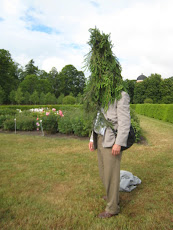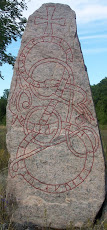lecture at the Municipal Theatre
Danjel Anderson gave an exposition of the developement of the Performance Art tradition centred around its implications for theatre. It opened for an approach to the field that would be unavailable from a Visual Art perspective. Four fundamental concept were involved convention, quality, blood, and audience. Performance art needs convention to transgress, or brake it, thus creating a possibility for the audience to experience itself and the act in a new perspective. In this setting the concept of quality is reversed as the teather performance is judged relative to established convention and convention is what should be challenged in the first place. Both convention and quality judgments maintains the aesthetic distance that performance art tends to break down. Blood is a useful mean for that end. It has an immediate impact on people which goes beyond reason. Like in a shock reaction perception is changed by the mere sight of blood. The audience gets involved in the scene in a way that seems characteristic of performance art. The audience is regarded as a witness rather than a distanced spectator.
We ended up at Nybron after the lecture by Danjel Andersson on the fundamental elements of performance art. There had been a lot of talk involving blood and we were pretty upset by some film sequenses from I Apologize, an intriguing work with dolls by Gisèle Vienne and Dennis Cooper. Timing in the work was distorted as blood was poured on the floor before the head ended up in the pool, and the shot was fired even later. Christina Eriksson Fredriksson was enthusiatic over the way time and narrative was handled. It made her see events in her own life in a new way. It reminded me of the spacetime of icons, and the reversed perpective. It had a strong impact on me as well. WE felt lik transported to a surrealist dimension were anything was possible.
Monday 11 August 2008
Friday 8 August 2008
Spiral, by Roi Vaara
Colour code: B4, G4, Y1, R1
Roi Vaaras work Spiral is a core performance artwork. It is highly creative and conceptually charged, but has only slight elements of emotional involvement and mental disturbance. The artist writes on the pavement of the Court Yard of Upsala Castle a series of concepts characterising destructive tendencies in contemporary culture. The writing took the form of a spiral, which seemed to cause the artist to lay down his pencil and wheel around until he fell to the ground. After a while he recovered and started scoring out the words of the spiral replacing them from the end towards the beginning with new ones. Thus an old concept crossed out became paired with a new, akin but slightly more favourable counterpart forming a set of surrealistic twins. White House became a pair with Black Hole for example.
Of course the strong political implications of the chosen words might be mentally disturbing to some, but for me the only disturbing thing was the loss of political meaning in the aesthetic context of the Art Museum. This however was of minor importance to the experience of the work. Its associative richness opened new alleys for the thought, and its creativeness made it impossible to predict the next move of the artist. In the end the impression was one of a strong logical unity and impact.
The likeness of Vaara's Spiral to the traditional rune stone inscriptions was not intentional, but created a new dimension in the work determined by the place. In other circumstances the modern graffitti writing might have a similar function. Not every aspect of an artwork need to be predictable or intentional.
Roi Vaaras work Spiral is a core performance artwork. It is highly creative and conceptually charged, but has only slight elements of emotional involvement and mental disturbance. The artist writes on the pavement of the Court Yard of Upsala Castle a series of concepts characterising destructive tendencies in contemporary culture. The writing took the form of a spiral, which seemed to cause the artist to lay down his pencil and wheel around until he fell to the ground. After a while he recovered and started scoring out the words of the spiral replacing them from the end towards the beginning with new ones. Thus an old concept crossed out became paired with a new, akin but slightly more favourable counterpart forming a set of surrealistic twins. White House became a pair with Black Hole for example.
Of course the strong political implications of the chosen words might be mentally disturbing to some, but for me the only disturbing thing was the loss of political meaning in the aesthetic context of the Art Museum. This however was of minor importance to the experience of the work. Its associative richness opened new alleys for the thought, and its creativeness made it impossible to predict the next move of the artist. In the end the impression was one of a strong logical unity and impact.
The likeness of Vaara's Spiral to the traditional rune stone inscriptions was not intentional, but created a new dimension in the work determined by the place. In other circumstances the modern graffitti writing might have a similar function. Not every aspect of an artwork need to be predictable or intentional.
Thursday 7 August 2008
Performance Takes Place
A challenge to the idea of a fixed meaning of the concept of art lies at the heart of the performance art movement. An element of provocative transgression therefore is vital to performance art. This make performance akin to the Kantian concept of free beauty, to surrealist views on art, to critical theory, and to the concept of symbolic form. All these themes are important elements in 20th century philosophy of art.
We don't understand words by definitions, we understand them as they are used in a specific context. The same can be stated about the understanding of art. In a the case of a performance artwork the stakeholders understand the meaning of the work from their different perspectives. The artist, the critic, the audience, the hosting institution, the sponsors, all have different views on the same work. Occasionally there are conflicting interests involved.
An art form that is self conscious, and reflective needs to take into account and interact with a host of dimensions as it takes place. That is why we may high light the way a performance is Taking Place, by using metaphors of war. The inauguration ceremony with seniors and their rollators climbing the hill of the Upsala Castle accompanied by Giuseppi Verdi's La Forza del Destino/The Power of Destiny, then, may be set in pair with the rock album by Brian Eno named Taking Tiger Mountain By Strategy after the model play of Chinese opera during the cultural revolution.
Now, the work by SU-EN is eccentric in relation to the established definition of Performance Art, but it is still a work in the performing arts, and it performs the actual inauguration of the festival. Three different uses of the concept of performance are presented in the work and thereby the theme of the festival is well caught in this single work. The span of performance art interlacing with contradictory definitions creates a complex serpentine gestalt akin to the rune-stone ornaments characteristic of the Swedish Viking culture.
We don't understand words by definitions, we understand them as they are used in a specific context. The same can be stated about the understanding of art. In a the case of a performance artwork the stakeholders understand the meaning of the work from their different perspectives. The artist, the critic, the audience, the hosting institution, the sponsors, all have different views on the same work. Occasionally there are conflicting interests involved.
An art form that is self conscious, and reflective needs to take into account and interact with a host of dimensions as it takes place. That is why we may high light the way a performance is Taking Place, by using metaphors of war. The inauguration ceremony with seniors and their rollators climbing the hill of the Upsala Castle accompanied by Giuseppi Verdi's La Forza del Destino/The Power of Destiny, then, may be set in pair with the rock album by Brian Eno named Taking Tiger Mountain By Strategy after the model play of Chinese opera during the cultural revolution.
Now, the work by SU-EN is eccentric in relation to the established definition of Performance Art, but it is still a work in the performing arts, and it performs the actual inauguration of the festival. Three different uses of the concept of performance are presented in the work and thereby the theme of the festival is well caught in this single work. The span of performance art interlacing with contradictory definitions creates a complex serpentine gestalt akin to the rune-stone ornaments characteristic of the Swedish Viking culture.
Subscribe to:
Posts (Atom)


